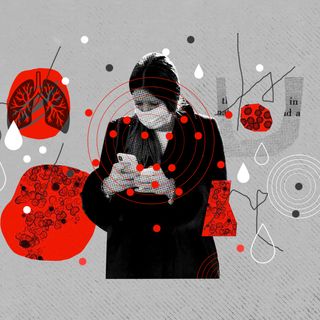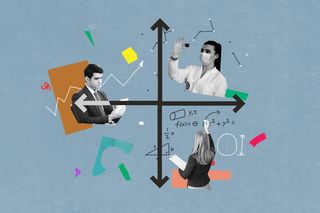
The MBTI Personality Typing Test Has No Basis In Science; So Why Do We Keep Taking It?
Developed by a mother-daughter team in the early 20th century, these types are everywhere from corporate culture to dating app bios.

Sherlock Holmes was an INTP. Moriarty was an INTJ. Robert Downey Jr. is an ENFP. The person you swiped left on your dating app was an INFJ. The simple, four-lettered sixteen personality types of the Myers-Briggs Type Indicator (MBTI) have slowly seeped into our cultural consciousness over the past decade, to the point where they sit comfortably amid the zodiac sign and the Hogwarts house as fun methods we use to define ourselves. Many other popular personality typing methodologies exist with their own fan followings — the Enneagram, the Big Five, Type-A/B personalities and more. Yet, the Myers-Briggs typing method is what finds itself discussed everywhere — with friends and crushes, in corporate culture, about celebrities, in Buzzfeed quizzes, and as a character development aid for fanfiction writers’ intricately detailed fanfiction.
Developed between the 1920s and 1940s by a mother-daughter duo — Katharine Briggs and Isabel Briggs-Myers respectively — the personality indicator owes its origins to Carl Jung’s Psychological Types. In this book, the founder of analytical psychology postulates the division of people into approximately eight different types: Introversion (I), Extraversion (E), Intuitive (N), Sensing (S), Thinking (T), Feeling (F), Perceiving (P), and Judging (J). Combining the above might make an INTP, ISFJ, ENTJ, and more! This test then went on to be administered in various corporate set-ups to accomplish everything from evaluating employees to screening interviews.
However, the MBTI testing and typing system is no accurate way to measure something already as volatile as human personalities. This is mainly because the test was created at a time when psychology was a still-developing field. Jung himself wrote Psychological Types after mining from his personal experiences. Plus, neither Briggs nor Briggs-Myers were trained psychologists who could attest their findings to expertise and specific research methodologies. “There’s just no evidence behind it,” Adam Grant, an organizational psychologist at the University of Pennsylvania, told Vox. “The characteristics measured by the test have almost no predictive power on how happy you’ll be in a situation, how you’ll perform at your job, or how happy you’ll be in your marriage.” Grant also points out that the system is extremely binary, which often leads to individuals pigeon-holing themselves into types like ‘introvert’ or ‘extrovert’ when they could be squarely in the middle — that is, both.”These categories all create dichotomies, but the characteristics on either end are either independent from each other, or sometimes even go hand in hand.”
Related on The Swaddle:
Why the Myth That Birth Order Shapes Personality Just Won’t Die
In attempting to know why the MBTI became as popular as it did, one must understand both Briggs and Briggs-Myers’ motives behind creating it. Briggs, who read Jung in the 1920s and decided to create a typology after his theories, was a mother. Her main motive behind the creation of the typing indicator was to create a tool that would type one’s children and help parents understand their interests and career inclinations. Her daughter, Briggs-Myers, continued work on the MBTI in the 1940s, but with a new perspective — workers. Briggs-Myers felt that the personality tests utilized, then divided, workers into good and bad, which she believed unfair. She created the MBTI in order to ensure people understood they were created equal, just different. This perhaps holds the key to the MBTI typology’s clear success — it never paints a personality in any negative light. Each of the sixteen types find themselves described in deeply diplomatic, encouraging manners — which suggests the MBTI is more a tool to highlight the best of ourselves than a tool to understand ourselves.
In a podcast hosted by the University of Pennsylvania’s Wharton Business School, academic Merve Emre spoke about the aptitude testing industry’s interest in personality tests, especially for the purpose of college admissions. She said, “They were interested in finding a test that could do for personality testing what the SAT had done for aptitude testing, which was that every college would use it to help determine their admissions. They were trying to validate [MBTI], and they couldn’t. Their team of statisticians could not find a way. They just couldn’t find proof for the fact that the questionnaire measured the categories that it claimed to measure, or that it was even reliable. Over 50% of people who took it got a different result when they took it a second time.”
Emre, who wrote The Personality Brokers: The Strange History of Myers-Briggs and the Birth of Personality Testing, concluded that once there was no scientific validity to the MBTI system, it was just a method that employers used to make employees feel special — whether or not this sentiment actually translated into actual benefits for employees.
Related on The Swaddle:
Science Has Identified Four New Personality Types. Which One Are You?
Due to its lack of scientific validity, the MBTI may not be the best method to judge one’s college aptitude, or their value at a place of employment, but that doesn’t make it completely invaluable. According to Emre, “I think we are hungry for the kind of self-knowledge that it presents. We are seduced by the fact that it presents that knowledge in a painless and easily digestible way. I think we are also incredibly compelled by the fact that enough people around us know the language of type, so that if I tell you I’m an ENTJ, you know exactly what that means. You might even be able to conjure up some famous people or literary characters or TV stars whose types are also ENTJ.”
Whether it be self-knowledge or conversation, the MBTI is a fascinating, low-stakes manner to get to know oneself or understand the bare minimum of how personality types interact with one another. As long as we all know its place in the thin line between pop psychology and serious psychometric testing, as Emre said, “It is a way of making meaning of a world that is messy and complicated.”
Aditi Murti is a culture writer at The Swaddle. Previously, she worked as a freelance journalist focused on gender and cities. Find her on social media @aditimurti.
Related


How Misplaced Emotional Arousal Can Lead People to Fall in Love
